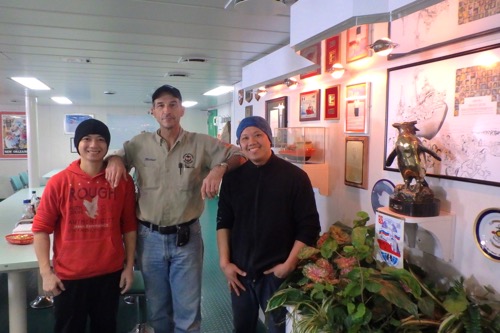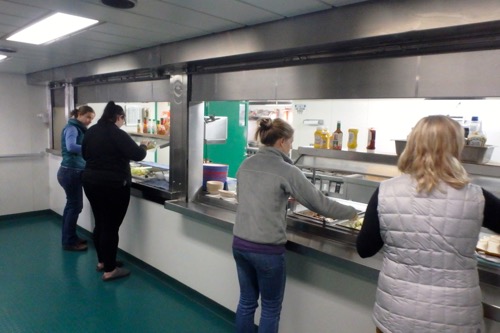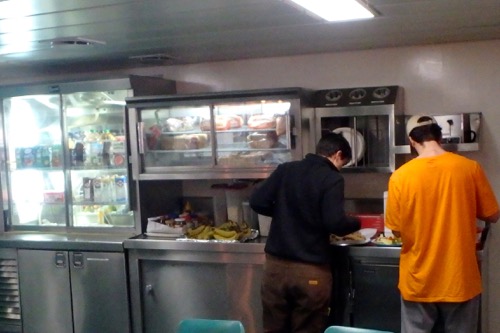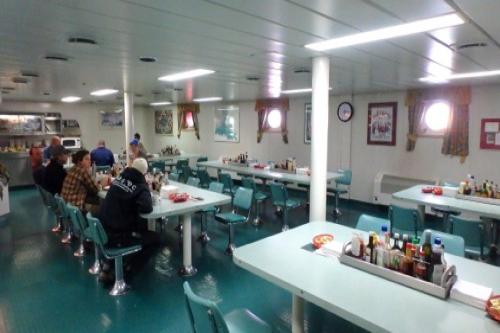Science Update
For the past few days, I have been denying the fact that this research cruise is close to an end. Today, however, there is no denying the obvious. The incubation van is empty. Incubation 3 was sampled for the last time today, bringing the three rounds of experiments to a close. Underway sampling will still continue through the Drake PassageStrait, connecting the Atlantic and Pacific oceans between Tierra del Fuego and the South Shetland Islands. Located about 100 mi (160 km) north of the Antarctic Peninsula, it is 600 mi (1,000 km) wide. and other seawater samples could be collected depending on when we reach open water, but we are definitely reaching the end. It is time to finalize sample counts, fill out appropriate paperwork, and pack samples and equipment.
Ice Update
It is still slow going, but, we are still moving forward. Yesterday, I was able to see the swells of the open water a few miles away. The temperature is slightly cooler today, which could help solidify some of the slushy snow. I have been asked if folks seem angry or frustrated by the slow progress. I am sure that frustration is felt by many because of the loss of science days, but that frustration is paired with the knowledge that this is part of working in the field. Our ice (well, really snow) problems could be a mud slide, torrential rains, high winds, a sand storm, etc. depending on the location of the field work. Field work is unpredictable, therefore, you need to approach it with sensibility and flexibility. The science team and crew have worked out plans for these last few days before we must leave for Chile – all dependent upon when we leave the ice. If we get out today, we may be able to do more sampling. If it takes longer to move through the ice, we may not. Regardless of the outcome, the previous 5 weeks of the research cruise have been extremely fruitful and will yield large amounts of data for analysis.
Galley Duty
When I am home and in charge of my own meals, I generally make a plan for the week. I go to the grocery store with a list and pick up the exact items that I need in order to prepare a menu for the rest of the week. If I forget something, don't end up with enough meals for the week, or decide that I want something else instead, I can easily get to a grocery store within a mile of my house or work. This scenario does not work if you are the galley staff on a ship. Michael Belloli (head cook/steward), Andy Prado and Ralph Dela Cruz are responsible for the planning and preparation of every meal aboard the RVIB Palmer. Three meals (sometimes four) a day are served regardless of sea conditions, deck operations, etc. The catch – no grocery store for (many) miles. To find out more about how to prepare meals for 40-70 people on a ship, I sat down with Michael Belloli to discuss his duties in the galley.

Culinary Expertise
Michael Belloli is a graduate of the Culinary Institute of America and a certified Executive Chef through the American Culinary Federation. Mike's previous culinary experience is extensive, working in restaurants, hotels, and on private yachts. Wanting a little change of pace, Mike began working for Edison Chouest Offshore (ECO) about two years ago. Mike enjoys working offshore and admits that part of the fun is the challenge of cooking using only the supplies at hand. Here is some important background before I continue – when Mike arrives on the ship, all of the food for the cruise is already aboard. The catch – Mike didn't have anything to do with the order. The food for our research cruise was ordered during the last cruise – a few weeks before Mike set foot on the RVIB Palmer. So, when Mike arrives a few days before the ship departs, his job is to inventory, organize, and store all of the food and then begin meal planning for the weeks ahead using what someone else provided for him.
Mike's philosophy is to be creative with what he has in stock in order to make a quality product that people will enjoy. Mike likes to make meal time special for the crew and science teams by providing musical entertainment (Motown to Eminem to Johnny Cash and everything in between), taking requests for favorite food items and interacting with every person in order to get to know individuals likes and dislikes. Mike, Andy, and Ralph truly embody the idea of service with a smile.


Checks and Balances
As part of the planning process, Mike is constantly checking the large walk-in freezer and walk-in cooler to see what is available and what is not. He says that it is important to keep track of the food items that you have available so that you know what you should use first and what items will keep longer than others. It is this constant oversight of the inventory that allows Mike to create a variety of meals each day and to provide fresh produce as long as possible. You may be surprised to know that yesterday (almost 5 weeks after leaving port) I had fresh iceberg lettuce and tomatoes in my salad and a banana for my afternoon snack. While these fresh produce items are not as readily available as they were at the beginning of the cruise, Mike's experience with storage and use of food is evident with each meal.

Favorite Meal
When I asked Mike what he enjoyed preparing in the kitchen, he simply stated, "whatever I am cooking that day". Mike puts his focus into the meal of the day in order to make sure that the food is special and that folks want to come to eat at every meal. I asked some of the science team about their favorites meals or food items during the research cruise and here is what they said:
- Chili mac-and-cheese
- Teriyaki chicken with fried rice (a favorite of many)
- Tacos and enchiladas
- Breaded white fish with a Cajun remoulade
- Fried chicken tenders
- Beef brisket with fried shrimp (surf n turf)
- Mushroom barley soup
- Grilled cheese with tomato
- Mango/chicken pizza
- Pancakes
- ALL of the desserts (there is always some type of dessert set out at lunch and dinner)
The list could go on and on! As you can see, creativity and variety are the name of the game in the galley on the RVIB Palmer.
THANKS MIKE, ANDY AND RALPH!


Comments